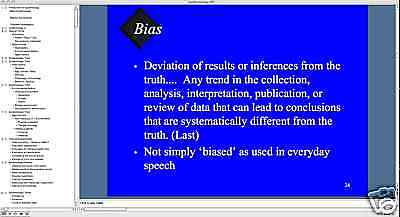92 page EPIDEMIOLOGY 101 PowerPoint Presentation on CD For Sale

When you click on links to various merchants on this site and make a purchase, this can result in this site earning a commission. Affiliate programs and affiliations include, but are not limited to, the eBay Partner Network.
92 page EPIDEMIOLOGY 101 PowerPoint Presentation on CD:
$9.99
Thank you!
If you do not wish to have your item(s) delivered on data disc(s), I can provide them on a flash drive and other means as well. Just let me know if a disc does not work for you and we can discuss delivery by other methods.
COMBINING SHIPPING COSTS
Are you purchasing multiple items? I will: a) combine all invoices before payment and charge shipping equivalent to one item, or b) refund all shipping costs in excess of one item after payment.
All derivative (i.e. change in media; by compilation) work from this underlying U.S. Government public domain/public release data is COPYRIGHT © GOVPUBS$3.00 first class shipping in U.S. and rest of world.
Includes the Adobe Acrobat Reader for reading and printing publications.
Contains the following key public domain (not copyrighted) U.S. Government publication(s) on one CD-ROM in both Microsoft PowerPoint and Adobe Acrobat PDF file formats:
TITLE: Introduction to Epidemiology, 92 pages (slides)
SLIDE TOPICS, SUBTOPICS and CONTENTS:
Introduction to Epidemiology
Basic EpidemiologyMedical SurveillanceOutbreak Investigation
Epidemiology is
The study of the distribution and determinants of health-related states and events in specified populations and the application of this study to the control of health problems. (Last)
Special Terms
Distribution
Person, Place, Time
Not randomly distributed
Determinants
Host factors
Environmental factors
Agent factors
Epidemiologic Triad
Epidemiologic Triad
Host Factors
Genetics
Age, Gender, Race,
Ethnicity
Physiology, Immunology
Behavior, Nutrition
Epidemiologic Triad
Environmental factors
Physical environment environment
Socioeconomic environment
Epidemiologic Triad
Agent factors
Non-Infectious (? = Environment)
Physical properties
Transfer of energy
Infectious of Epidemiology
Historical study – Worse or better?
Population assessment
Evaluation of individual health risks
Evaluation of interventions
Completing the clinical picture
Etiology of injury and disease
Epidemiologic Method
Observe and count (‘tick marks’)
Relate events to the population at risk
Make comparisons
Develop hypothesis
Test the hypothesis
Make scientific inferences / experiment
Intervene and evaluateEpidemiologic Terms
Prevalence
Incidence
Crude or adjusted ratesNOTE: P ~ I x D
Epidemiologic Terms
Relative Risk
Odds Epidemiology
Person, Place and Time
Case report
Case series
Ecologic studies*
Cross-Sectional studies*
Analytical Epidemiology
Tests hypotheses about causation
Usually follow descriptive studies
Observational or Experimental
May be used to make decisions
Institute or modify preventive programs
Legislative actions
Evaluate effectiveness of a preventive program
Observational Epidemiology
Observation of the occurrence of a condition or disease in people who are already segregated into groups on basis of some experience or exposure
Cohort study
Case-Control studyCohort Study
Subsets of the population can be identified by exposure status before the onset of disease. The subsets are then followed over time to determine rates of disease by exposure status.
aka ‘Prospective Study,’ ‘Longitudinal Study,’ ‘Incidence Study,’ etc.
Cohort Study
Yields rates of disease
Measure of association is the Relative Risk
Good for looking at all results of an exposure
Expensive in time and moneyRate of Disease
Cohort Study
ILL
Relative Risk (Rate Ratio)
RR = Rate in Exposed
Rate in UnexposedCase-Control Study
Subjects are selected on the basis of disease status: Those with disease (cases) or those without disease (controls). The PAST exposures of the two groups are compared.
aka ‘Retrospective Study’
Measure of association is the Odds Ratio
Subject to ‘Recall Bias’
Case-Control Study
ILL
Case-Control Study
Odds that ill were exposed in the past = a/c
Odds that controls were exposed = b/d
ODDS RATIO (OR) = (a/c)/(b/d) = ad/bc
OR approximates RR (if disease is rare)
“Things are not always what they
Deviation of results or inferences from the truth.... Any trend in the collection, analysis, interpretation, publication, or review of data that can lead to conclusions that are systematically different from the truth. (Last)
Not simply ‘biased’ as used in everyday speech
Sources of Bias
Selection bias
Information bias
Comparison bias
Confounding
A situation in which the effects of two processes are separated. (Last)Confounded?Does gray hair cause heart attacks? Review this study supported by the Grecian Formula Institute of Public Health...Confounding
Age < 40
Age > 40
Interaction
The interdependent operation of two or more causes to produce or prevent an effect
The effect of one or more factors varies as a function of the level of another factor
aka synergism (antagonism), effect modification
Disease Surveillance
Purpose of Surveillance
Determine baselines
Natural history of disease
Describe trends
Detect epidemics
Plan and set priorities
Detect rare / dispersed disease
Evaluate interventions
Disease Surveillance Cycle
Collection of data
Consolidation of data
Analysis of data
Dissemination of reports
Action to control and preventSources of Surveillance Data
Vital statistics
Health reports
Hospital and Non-Battle Injury (DNBI) Surveillance
DoD (JCS) directed
Routine collection & reporting of all military medical encounters
Includes reportable events
Data collected at lowest echelon of medical care
Analyzed data flow back to reporting units
US DoD DNBI Rates
An early warning system
Focus attention on problems
Measure effectiveness of interventions
Identify areas of preventable disease and injury
The ‘Vital Signs’ of the military unit
DNBI Weekly Report
Summary of weekly DNBI rates
Provides baseline
Reliant on a PROPER Sick Call Logbook or Daily Patient Log Form
Sick Call Logbook
Patient info
Name, SSN
UNIT & UIC
Duty location
Chief Complaint
Diagnosis
Type of visit
INITIAL
FOLLOW Duty / Profile
Lost Duty Day / Quarters
Admit
Injury Classification
Recreational / Sports
MVA
Work / Surveillance Worksheet
Daily and routine process
Simplifies weekly DNBI reporting
Admin data at top of form
TROOP STRENGTH refers to the number of persons supported by the MTF (by gender)
TROOP STRENGTH obtained from S-1/J-1
Record DIAGNOSIS for each INITIAL visit
Record LIGHT DUTY, LOST DUTY daysDiagnostic Categories
Combat/Operational Infectious
Gynecologic
Heat/Cold Injury
Injury, Recreational/Sports
Injury, MVA
Injury, Work/Training
Injury, unknown origin
All other, (open)
Rate Calculation
Divide number of patients seen that week for each category by average troop population at risk
For gynecologic category, divide by number of females
Multiply by 100 (to get percent / week)
EXAMPLE: 20 DERM cases last week in a unit of 500 soldiers
20/500/wk = 0.04/wk; 0.04/wk X 100 = 4%/wk incidence for DERM encounters
Record number of estimated LIGHT / LOST DUTY daysDNBI Rate Analysis
Compare observed rate with reference rate
CINC SURGEON or JTF SURGEON may modify reference rates
Look for trends in disease rates
Comment on “PROBLEMS IDENTIFIED AND CORRECTIVE ACTIONS”DNBI Surveillance
Sum of references rates may NOT equal total DNBI reference rate
Rate of one category can be high with low total DNBI rate
DNBI rate can be high without busting any one disease category
Track DNBI rates over time and compare to historical rates
DNBI rates vary with phase of deploymentField Epidemiology: Outbreak Investigations
Outbreak Investigation Overview
Procedures for outbreak investigationsPITFALLS!Data analysis
Outbreak Investigation ProcessesPrepare for field work
Establish existence of an outbreak
Verify the diagnosis
Define and identify cases
Perform descriptive epidemiology
Outbreak Investigation Processes (cont.)
Develop hypothesis
Evaluate hypothesis
Reconsider/refine hypothesis
Implement prevention/control measures
Communicate findings
1: Prepare for Field Work
Investigation
Scientific knowledge--have it or get it!
Laboratory consultation
Supplies, equipment
Administration
Review SOPs, local directives
Consultation
Know your role, especially when other agencies involved
2: Establish the Existence of an OutbreakDetermine if disease incidence is higher than expected in this populationThe primary reason for disease surveillance!
Other Reasons for ‘Outbreaks,’ i.e., Observed Cases > Expected
Change in reporting procedures
Changes in case definition
Increased awareness or public interest
Improved diagnostics
New clinician
Population change
3: Verify Diagnosis
Ensure proper diagnosis
Rule out lab error
Visit and interview patients
Better understanding of clinical
features
Mental image of outbreak
Set up frequency distributions
Frequency Distribution
4a: Establish a Case Definition
Critical to success of investigation!
Definition composed of:
Clinical criteria: simple and objective
Epidemiologic variables: person, place, time
Case Definitions
Clinical criteria examples
Titer elevation
Fever 101 degrees and above
3 or more loose bowel movements/day
Myalgias severe enough to limit activitiesEpidemiologic variables
Persons w/no immunity to or past Hx of rubeola
Place: Workers, attendees of child care center
Time: Contact period 14-20 FebruaryClassification of Case Definitions
Definite caseProbable casePossible case
Classification: DEFINITE CASE
“Confirmed”
Usually lab verified
Last to arrive
Example: E coli O157:H7 isolated from stool culture or development of HUS in a school-age child with GI symptoms beginning between 3 November and 8 November 1996
Classification: PROBABLE CASE
Case has typical clinical featuresNo lab confirmation (may be pending)
Example: Bloody diarrhea with the same
person, place, and time restrictionsMay be only case definition in certain cases
Classification: POSSIBLE CASE
Fewer typical clinical features Epidemiologic variables: same, but some data may be missing
Example: Abdominal cramps and diarrhea (at least 3 stools in a 24-hr. period) in a school-age child with onset during the same periodDon’t lose track of them!
Case Definition Development
Early in investigation: INCLUDE definite, probable, and possible casesLater: sharper focus --tighten definition to increase specificity
4b: Identify & Count Cases
“Cast a wide net”--expand
investigation
Use multiple sources; be diligent
Ask case-patients
Information Collection
Identifying info: name, SSN, address, phones
Demographic info: age, sex, race, worksite, occupation
Clinical info: verify against case definition; get onset date
Risk factor info: disease-specific (e.g., HA: inquire about exposure to risky foods/water; overeats travel)
Reporter info: staff member or person providing case report
Information Collection (cont.)
Collect on standard case report form or questionnaire
Use line listing!
Add new cases as they become known
Contains key information on every interview
Classify as case or non-case/control5: Perform Descriptive Epidemiology
Person
Place
Time
Descriptive Epi: Person
Host characteristics: age, race, sex
Exposures: occupation, leisure activities,
medications, drugs
Disease-specific risk factors: sexual exposure, IV drug use, etc..
Descriptive Epi: Place
Spot map: simple and effective
Identifies:
Geographic extent of outbreak
Clustering or patterns
Applications
Communities: residence, work, environ.
Facilities: hospitals, dining hall seating arrangements, worksites, surgical suites
Descriptive Epi: Time
Draw epidemic curve
No. of cases by time of onset or DX
Tells us:
“Where are we now?”
“What’s the forecast?”
Probable time of exposure (maybe)
Epidemic patternEpidemic Curves
Epidemic Curves
Epidemic Curves
Descriptive Epidemiology
Summarize your findings
Use the typical, predominant descriptors
Generalize
Don’t worry about political correctness!
6: Develop Hypotheses
Should address:
Source
Mode of transmission
Exposures that caused disease
Requires familiarity with disease--consider what you know
Case-patient interviews give insight
Hypothesis should be testable
Develop Hypotheses (cont.)
Discuss with local HD
Still clueless?
Convene group-pt. meeting
Visit homes--plunder
Don’t forget outliers
MAY give best clues because they’re somehow different from norm--
7: Evaluate Hypotheses
Two methods:
Compare hypothesis with the established facts
Analytic epidemiology
Quantify relationships
Explore the role of chance
Hypothesis Evaluation: Comparative Method
Clinical, laboratory, environmental, and/or epidemiologic evidence overwhelming
Example:
All cases had bloody diarrhea; E. coli (EIEC) isolated from stools
All had same ready-to-eat food; no other common exposures
Salad preparer at restaurant had same strain E. coli 2 wks earlier; known not to practice good hygiene
Hypothesis Evaluation: Analytic Method
Cohort study--best for small, well-defined outbreaks
Population at risk easily located/recognized
Ill/well interviewed
Calculate attack rates--”ate” vs “didn’t eat”
Put on food-specific attack rate table
Analytic Method (cont)
Relative Risk Calculation
Analytic Studies
Case-Control studies
Use when population not well defined
Must select controls as comparison group
Should not have disease in question
Representative of population
Examples: random sample, friends, neighbors, family, other patients
Use odds ratio as measure of association
between exposure and disease
Analytic Method (cont)
Statistical significance testing
Explores role of chanceChi-square (X2) most common
Greater risk difference = Larger chi-square
Sample size/denominator big influenceAnalytic Method (cont)
p-value
Probability of finding a difference in risk
at least as strong as the one you just observed
if there was actually no difference in risk.
Large X2 => small p-value
De-emphasize in small outbreaks
Analysis: Bottom Line
Rely primarily upon . . .
Differences in risk between exposed and non-exposed
Biologic plausibility
Common sense8: Refine Hypothesis / Additional Study
Unrevealing analytic studies likely if hypothesis not well-founded
If descriptive epi unrevealing, analysis useless
Reconsider; work another angle
Consider new vehicles or modes of transmission
Meet with case-patients; visit homesAdditional Studies
Laboratory Studies
Lab evidence can clinch findings
Sometimes absolutely necessary to close investigation
Environmental Investigations
Often answer “why” outbreak occurred9: Implementation of Control & Prevention MeasuresAim at weak link(s) in chain of infectionApply to agent, source, or reservoir
Destroy contaminated food
Disinfecting contaminated water
Destroy vector breeding sites
Control & Prevention Measures (cont.)
Interrupt transmission or exposure
Personal protective countermeasures
Reducing host chemoprophylaxis
10: Communicate the Findings
Include descriptive epidemiology
Be objective
Serves as a reference and historical document
Outbreak Investigation Summary
Use a SYSTEMATIC approach
Establish the case definition early
Descriptive Epi is important
Statistics are only a tool
Always COMMUNICATE finding

Related Items:
TALES OF SUSPENSE #92 CGC 9.4 OW-W PAGES MARVEL COMICS 1967 NICK FURY + AVENGERS
$309.99
Spawn #3 Newsstand 92' CGC 9.8 White Pages New Slab
$229.95
Spawn #1 CGC NM/M 9.8 White Pages McFarlane 1st Appearance Al Simmons
$159.00



